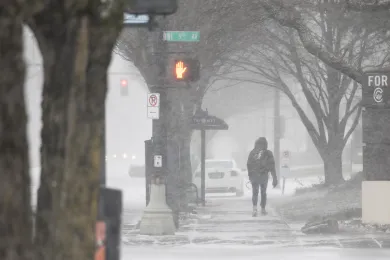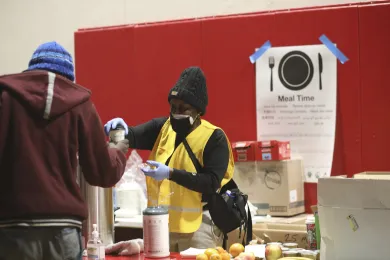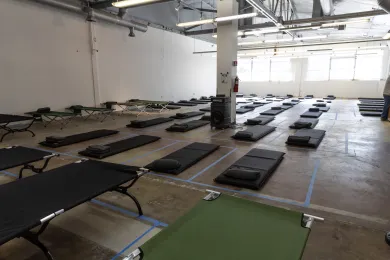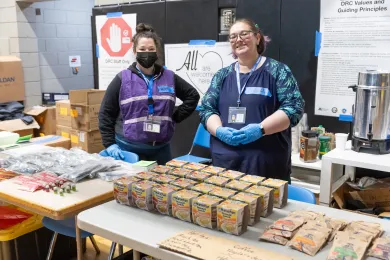Updated 9:55 a.m. Monday, Dec. 29, 2025
Not open:
- Emergency severe weather shelters.
Open:
- Multnomah County and the City of Portland’s nearly 3,000 year-round shelter beds, along with the City of Portland’s overnight-only shelter beds. (To see which overnight-only sites have beds available, visit this interactive map.)
Weather forecasts do not currently meet thresholds to open severe weather shelters.
Local officials use these thresholds — in consultation with National Weather Service experts, County Emergency Management, the Health Department, County Human Services, the Homeless Services Department (formerly the Joint Office of Homeless Services) and the Portland Bureau of Emergency Management — to activate emergency severe weather shelter plans.
Officials will continue to monitor forecasts through the winter season in the event that conditions require severe weather warming shelters to reopen.
Anyone seeking shelter should contact 211info by dialing 2-1-1 or 1-866-698-6155.
Multnomah County Library locations can provide a warm space during the daytime. Hours and locations can be found at this webpage (note that some locations are closed for construction).
If you are concerned about someone you see during colder conditions, such as an individual who is not dressed for the weather conditions, call the non-emergency response line at 503-823-3333 and request a welfare check.
If someone is unsheltered and their life appears to be in danger, call 9-1-1 for medical attention.
Volunteering to support our warming shelters when the time comes
During dangerous weather emergencies, Multnomah County opens life-saving Disaster Resource Centers (DRCs) across our community that offer people shelter, safety, resources and connection — especially those who are at greatest risk of harm. We often welcome the support of community members when the need arises. Visit the “Volunteer at a County emergency shelter” webpage to learn about info sessions and training opportunities, as well as emergency shelter roles and their requirements.
Thresholds for opening emergency shelter during severe weather
County staff monitor weather conditions and other factors, including temperature fluctuations, precipitation, windchill and emergency department visits for hypothermia. Once forecasts show the potential for thresholds to be met, officials meet daily to discuss those weather conditions — consulting with Emergency Management, Health Department, County Human Services and Homeless Services experts — and then jointly decide on shelter plans as needed.
Severe weather shelters open as needed when any of the following thresholds are met for any one of the conditions below that are forecasted to persist for four (4) hours or more between the hours of 8 p.m. and 7 a.m.
- Forecast temperature of 25° F (-4° C) or below
- Forecast temperature at or below 32° F (0° C) with 1 inch or more of rain and with sustained winds greater than 10 mph overnight
- Forecast snow accumulation of 1 inch (25 mm) or more over a 24-hour period
The County’s Chief Operating Officer or their designee may consider other conditions or circumstances during a severe weather event that could increase the risk to the community and activate elements included in this standard operating procedure.
The basic thresholds the County uses were first developed and used by the City of Portland, before the Joint Office of Homeless Services was created, when the City served as the lead agency providing severe weather shelter for adults experiencing homelessness. The County has since expanded the thresholds and added a separate cold weather response on nights when thresholds aren’t met.
Cold weather alerts for enhanced outreach
Even when severe weather thresholds aren't met, the Homeless Services Department may issue a “cold weather alert” as cold and wet conditions warrant. This activates enhanced outreach. Cold weather alerts do not activate the County’s response to open severe weather beds at additional warming shelters.
During enhanced outreach, providers conduct additional and focused outreach to find vulnerable people, and they can quickly obtain and distribute cold weather gear from the Joint Office supply distribution center. Providers will also step up coordination to share information on resources and available shelter. Overflow shelter capacity will be made available to outreach workers, who can refer people in need.
The following conditions lasting for four (4) or more hours overnight activate the highest level of enhanced outreach. In some cases, thresholds may be met only in certain zones; enhanced outreach can be specific to those zones.
- Temperatures forecast to reach 32° F or below, without precipitation
- Windchills forecast to reach 25° F or below, without precipitation
- Temperatures forecast to reach 34° F or below, alongside precipitation of more than one tenth of an inch.




